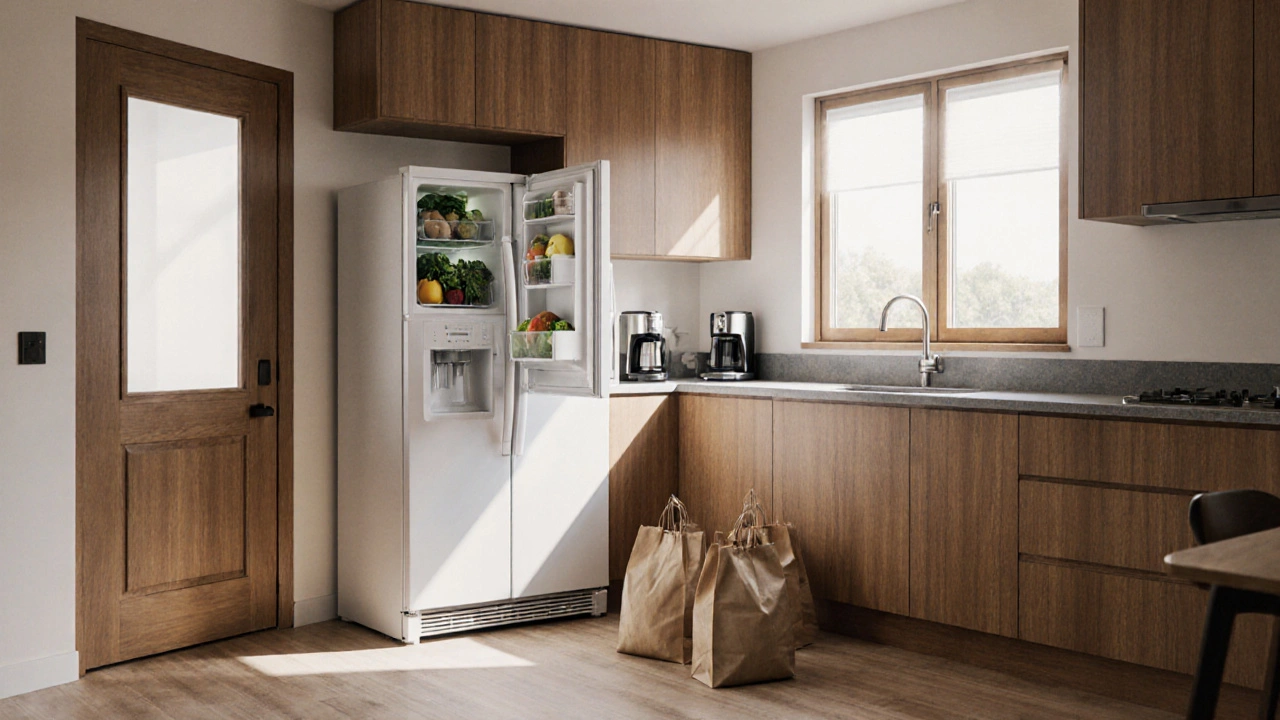
Kitchen Layout Calculator
Calculate if your fridge, sink, and stove form an optimal kitchen triangle. Based on article guidelines: each point should be between 1.2m and 2.7m apart, with total perimeter under 6.7m.
Results
Enter distances to see your kitchen triangle results.
Where you put your fridge isn’t just about space-it’s about how you actually live in your kitchen. A fridge stuck in a corner, jammed between cabinets, or too far from the prep zone can turn simple meals into a chore. You don’t need a designer to fix this. You just need to think about how you move.
Start with the Kitchen Triangle
The kitchen triangle-connecting the fridge, sink, and stove-isn’t just an old design rule. It’s a real-life rhythm. When these three spots are too far apart, you’re walking back and forth like you’re training for a marathon. Too close, and you’re bumping elbows while cooking dinner.
For most homes, the sweet spot is keeping each point between 1.2 and 2.7 meters apart. The total triangle perimeter should be under 6.7 meters. That’s not magic-it’s what works when you’re pulling out a chicken, rinsing it, and tossing it into a pan without tripping over your own feet.
Put the fridge where you naturally reach for it first. If you open it five times before you even turn on the stove, it shouldn’t be tucked behind the pantry. It should be near the entrance to the kitchen, where you walk in with groceries.
Don’t Block the Path
Imagine this: you’re carrying a bag of groceries, one hand holding a toddler, the other juggling keys. You walk into the kitchen. The fridge is right in front of you. Perfect.
Now imagine the fridge is in a narrow aisle between the island and the cabinets. You have to open the door wide to get to the milk. The door swings into the walkway. Now you’re stuck. You have to move the toddler, shift the bag, wait for the door to clear. That’s not design. That’s frustration.
Leave at least 90 cm of clear space in front of the fridge door. If it’s a side-by-side or French door model, you need even more-1.2 meters is better. That’s not a luxury. That’s safety. People trip. Doors swing. Kids run. Your fridge shouldn’t be a hazard.
Keep It Cool-Literally
Fridges give off heat. A lot of it. If you squeeze it into a tight corner next to the oven or under a window that gets afternoon sun, it’s working twice as hard. That means higher electricity bills and a shorter lifespan.
Check the manufacturer’s specs. Most fridges need at least 5 cm of clearance on the sides and back for airflow. Some need more. If your fridge is sweating or making a noise like a jet engine, it’s probably overheating.
Put it on an interior wall if you can. Exterior walls get colder in winter and hotter in summer. That makes the fridge fight the weather. An interior wall stays steady. Less work. Less cost.
Think About the Groceries
Where do you bring your groceries in? The garage? The back door? The front porch? That’s where the fridge should be.
Most people don’t realize this: the fridge should be the first thing you reach for when you walk in with bags. If you have to walk halfway across the kitchen to unload, you’ll drop things. You’ll forget the milk. You’ll leave groceries on the counter until they spoil.
In Auckland, where many homes have a side entrance or a laundry off the kitchen, putting the fridge near that entry point makes sense. It’s not about looks. It’s about habits. If you’re coming in from the garden with a basket of tomatoes, you don’t want to trek across the kitchen to stash them.

Don’t Isolate It
A fridge isn’t an island. It’s part of a team. It needs to work with the sink, the counter, and the prep zone.
After you pull out the meat, you want to rinse it. Then you want to chop it. Then you want to cook it. If the sink is on the other side of the kitchen, you’re walking back and forth with raw chicken. That’s a mess waiting to happen.
Place the fridge within arm’s reach of a prep counter. At least 60 cm of clear counter space next to it is ideal. That’s where you lay out ingredients. That’s where you take out the butter and the eggs without having to move again.
Some people put the fridge right next to the stove. That’s a bad idea. Heat from the oven makes the fridge work harder. Plus, you’re constantly opening the fridge while standing over a hot pan. You’ll get steam on the door. Condensation. Mold. It’s a recipe for trouble.
Consider the Door Swing
Most people don’t think about which way the fridge door opens until it’s too late. You buy a fridge. You install it. Then you realize the door hits the wall, the cabinet, or the island. Now you can’t open it fully.
Check the hinge side before you buy. Most fridges let you switch the door swing. But you have to do it before installation. If your kitchen layout forces the door to swing toward a corner, make sure it opens the right way.
If you have a narrow kitchen, consider a bottom-freezer model with a side-swing door. Or a counter-depth fridge that doesn’t stick out. These give you more room to move.
Real-Life Examples That Work
Here’s what works in real homes-not just in magazines.
- In a small Auckland apartment, the fridge sits just inside the kitchen entrance, next to the counter where the coffee maker lives. Groceries go in, coffee gets made, breakfast prep happens in one smooth motion.
- A family in Tauranga put their fridge beside the pantry, with a 1-meter counter between them. They pull out ingredients, grab what they need from the pantry, and prep on the same stretch. No extra steps.
- A couple in Wellington moved their fridge from the far end of the kitchen to the left wall, right by the back door. Now they unload groceries while the kids play in the yard. No more dropped bags.
None of these are fancy. No one hired an interior designer. They just watched how they used the space-and changed it.

What Not to Do
Here are the top three mistakes people make:
- Putting the fridge in front of a window. Sun heats it up. Condensation builds. Energy use spikes.
- Blocking the fridge with tall cabinets or a pantry. You can’t reach the back shelves. Food expires. You waste money.
- Putting it too far from the sink and stove. You’re walking 5 meters just to make a sandwich. That’s not cooking. That’s exercise.
If your fridge feels like an afterthought, it probably is. And that’s why your kitchen feels awkward.
Final Rule: Test It
Before you buy or move your fridge, simulate the workflow.
Grab a box. Put it where you think the fridge should go. Open the door. Pretend you’re pulling out milk. Walk to the sink. Pretend you’re rinsing. Walk to the counter. Pretend you’re chopping. Walk to the stove. Pretend you’re cooking.
Do you bump into anything? Do you feel cramped? Do you have to twist your body? If yes, move it.
It’s not about style. It’s about ease. A kitchen that works doesn’t need to look like a showroom. It just needs to let you cook without thinking about where things are.
Put the fridge where you need it-not where you think you should put it.
Can I put my fridge next to the dishwasher?
Yes, but with caution. Dishwashers release heat and moisture when they run. That can make your fridge work harder and cause condensation on the door. Leave at least 5 cm of space between them, and make sure the dishwasher has good ventilation. If your fridge door gets wet after every wash cycle, move it.
Should the fridge face the kitchen entrance?
It’s ideal, especially if you bring groceries in through the garage or back door. Having the fridge near the entry means you can unload quickly, without dragging bags across the whole kitchen. It also keeps the main cooking zone clear. But if the entrance is narrow or cluttered, don’t force it-prioritize clear access over direction.
Is it okay to put the fridge in a corner?
Only if there’s enough room to open the door fully and you can still reach everything inside. Corners are tricky-most fridges have deep shelves that become hard to access. Use pull-out organizers if you must put it there. But avoid deep corners unless the fridge is counter-depth and the door swings the right way.
What’s the best fridge size for a small kitchen?
Counter-depth fridges (around 65-70 cm deep) are the best for small kitchens. They don’t stick out past the cabinets, so you save space and improve flow. Look for models under 1.7 meters tall and 75 cm wide. You don’t need 600 liters of storage if you shop weekly. Focus on efficient layout, not volume.
Does the fridge need to be on a dedicated circuit?
In New Zealand, electrical codes recommend a dedicated circuit for fridges, especially newer models with digital controls. It prevents overloads and keeps your food safe during power surges. If you’re renovating, ask an electrician to install one. It’s a small cost for peace of mind.
Next Steps
If you’re planning a kitchen redesign, sketch your current layout. Mark where you open the fridge, where you prep, and where you cook. Time yourself making a simple meal. If you’re walking more than 5 steps between those points, it’s time to rethink the fridge.
Don’t wait for a full renovation. Try moving the fridge to a different wall. Just for a week. See how it feels. Most people realize they’ve been living with a bad layout for years-and a simple shift fixes everything.




